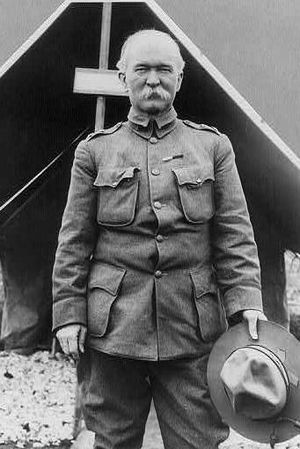William Harding Carter facts for kids
Quick facts for kids
William Giles Harding Carter
|
|
|---|---|

William Harding Carter
|
|
| Born | November 19, 1851 Nashville, Tennessee |
| Died | May 24, 1925 (aged 73) Washington, D.C. |
| Place of burial | |
| Allegiance | United States |
| Service/ |
|
| Years of service | 1873–1915, 1917–1918 |
| Rank | |
| Commands held | Hawaiian Department |
| Battles/wars | American Civil War Indian Wars Spanish–American War World War I |
| Awards | Medal of Honor Distinguished Service Medal |
| Other work | Writer |
William Giles Harding Carter (November 19, 1851 – May 24, 1925) was an important officer in the U.S. Army. He served in the Cavalry during several major conflicts. These included the American Civil War, the Spanish–American War, and World War I.
Carter also fought in the American Indian Wars, where he saw a lot of action. He served against the Apache and Comanche tribes in Arizona. For his bravery against the Apache in 1881, he received the Medal of Honor.
Beyond fighting, Carter was a strong supporter of making the U.S. Army better. He worked with the Secretary of War, Elihu Root, to create the U.S. Army War College. He also helped change how the army was organized. This led to the creation of the Chief of Staff position. Carter also supported the Militia Act of 1903. This law helped create the National Guard Bureau, which replaced older state militias.
Later in his life, Carter became a historian and writer. He wrote several books about military history. These included From Yorktown to Santiago with the 6th Cavalry and The Life of Lieutenant General Chaffee.
Contents
Early Life and Military Training
William Giles Harding Carter was born in Nashville, Tennessee. As a child, he went to both public and private schools. During the American Civil War, he worked as a mounted messenger. He carried messages for the Army of the Cumberland, which was a Union army.
After the war, Carter was accepted into the West Point military academy. He graduated on June 13, 1873. He became a Second Lieutenant. His first assignment was with the 8th U.S. Infantry in Wyoming. He also served at Fort Fetterman and Fort Laramie. In 1874, he joined expeditions against the Cheyenne, Brulé, and Oglala Sioux tribes.
Service in the American Indian Wars
In the summer of 1874, Carter moved to the Arizona Territory. He was stationed at Fort McDowell. He then transferred to the 6th U.S. Cavalry and later to the 5th U.S. Cavalry. He stayed at Fort Verde until May 1875.
Carter worked as an army scout at different posts in Arizona. He was often involved in small fights with local Native American tribes. From April to July 1876, he helped move the Chiricahua Apache people. They were moved from their reservation to the San Carlos Apache Indian Reservation. That same year, he also supervised the building of the first telegraph line from Fort Grant to Fort Apache.
Medal of Honor for Bravery
In 1878, Carter spent a year scouting in Arizona, New Mexico, and Sonora, Mexico. On April 14, 1879, he was promoted to first lieutenant. He then took part in the final battles against Victorio from June to October 1880.
The next summer, he joined the Comanche Campaign. He was an adjutant general to Colonel Eugene Asa Carr. On August 30, 1881, he showed great courage during the Battle of Cibecue Creek. He and two other soldiers rescued wounded comrades while under heavy enemy fire. For this brave act, he was awarded the Medal of Honor.
Rising Through the Ranks
Over the next few years, William Carter continued to advance in his military career. He was promoted to captain in 1889. Then he became a major in 1897, and a lieutenant colonel in 1898. By 1902, he was a colonel. He became a brigadier general in 1902 and finally a major general in 1909.
Before World War I, Carter was very involved in organizing the U.S. Army. In 1911, he created and led the Maneuver Division. This was the first modern army division that could support itself. In 1913, he commanded one of the four divisions in the "Stimson Plan." This was the 2nd Division (Central Department). Carter then became the commanding general of the Hawaiian Department. He retired from the army on November 19, 1915.
World War I Service
When the United States entered World War I, Carter was called back to duty. He was 65 years old. From August 1917 to February 1918, he commanded the Central Department of Chicago. For his service during the war, he received the Distinguished Service Medal.
Later Life and Legacy
In his later years, Carter suffered from serious breathing problems. He passed away at his home in Washington, D.C., on May 24, 1925. He was buried at Arlington National Cemetery.
His son, William Vaulx Carter, also became a Brigadier General in the army during World War II.
Awards and Decorations
Ribbon bar
| 1st Row | Medal of Honor | Army Distinguished Service Medal | ||||||||||||||||||||||||||||||||||||||||||||||||||
|---|---|---|---|---|---|---|---|---|---|---|---|---|---|---|---|---|---|---|---|---|---|---|---|---|---|---|---|---|---|---|---|---|---|---|---|---|---|---|---|---|---|---|---|---|---|---|---|---|---|---|---|---|
| 2nd Row | Civil War Campaign Medal | Indian Campaign Medal | Spanish Campaign Medal | World War I Victory Medal | ||||||||||||||||||||||||||||||||||||||||||||||||

